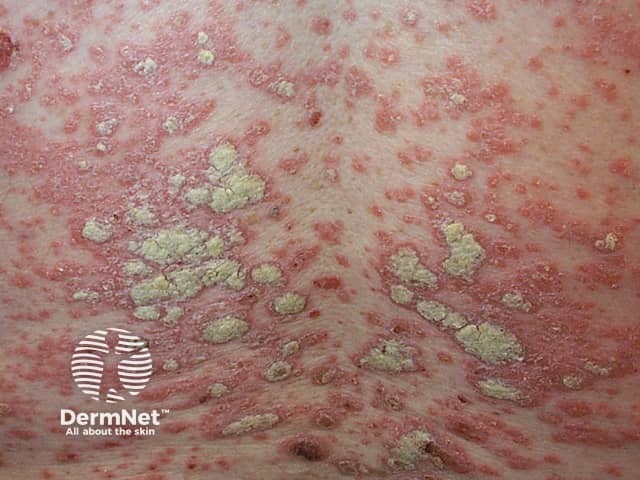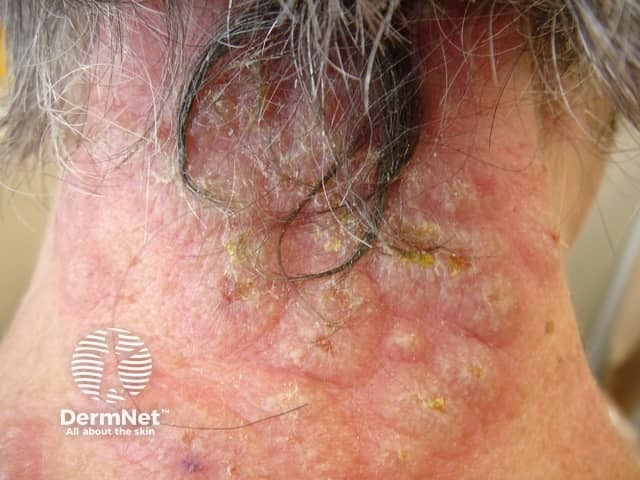Main menu
Common skin conditions

NEWS
Join DermNet PRO
Read more
Quick links
Inflammasomes and inflammatory skin diseases — extra information
Inflammasomes and inflammatory skin diseases
Author: Sheida Naderi-Azad, medical student, University of Toronto Faculty of Medicine, Toronto, ON, Canada. DermNet Editor in Chief: Adjunct Assoc. Prof. Amanda Oakley, Dermatologist, Hamilton, New Zealand. December 2019.
Introduction - innate immune response Introduction - inflammasome Introduction - inflammatory skin disease Inflammasomes in allergic contact dermatitis Inflammasomes in psoriasis Introduction - autoinflammatory disease Inflammasomes in autoinflammatory skin disease
What is the innate immune response?
The innate immune response refers to the parts of the immune system that are immediately functional. It includes:
- Physical barriers such as the tight junctions between cells of the epithelium and the mucociliary layer that overlays the epithelium in the respiratory, gastrointestinal, and genitourinary tracts
- White blood cells that identify and eliminate pathogens non-specifically
- Membrane-bound receptors and intracellular proteins — such as inflammasomes — that bind and eliminate invading microbes through a signal cascade [1].
What is an inflammasome?
An inflammasome is a part of the innate immune system. It is an intracellular complex that binds microbes and creates a signal cascade to attack them.
Inflammasomes include [2]:
- The nucleotide-binding oligomerisation domain (NOD)-like receptor (NLR) P3 inflammasome
- The absent in melanoma 2 (AIM2) inflammasome
- The NLRC4 inflammasome
- The pyrin inflammasome.
An inflammasome consists of [3]:
- A molecular pattern recognition receptor (PRR)
- An apoptosis-associated speck-like protein containing a caspase-recruitment domain (ASC) adaptor protein
- A caspase-1 enzyme.
Inflammasomes regulate the immunological response to exogenous stimuli (eg, bacteria) and endogenous stimuli (eg, neoplasia) via cytokine secretion, particularly interleukin (IL)-1β and IL-18, and induce neutrophil recruitment [4].
Inflammasomes also play an important role in acute and chronic inflammatory diseases [4].
What is an inflammatory skin disease?
Inflammatory skin diseases are characterised by the activation of the innate and adaptive immune system via the production of pro-inflammatory cytokines [4]. They are classified as autoimmune diseases and autoinflammatory syndromes or diseases.
Autoimmune inflammatory skin diseases such as vitiligo and lupus erythematosus involve aberrant responses to autoantigens, controlled by B cells and T cells, with the presence of autoantibodies.
Autoinflammatory skin diseases such as periodic fever syndromes and neutrophilic dermatoses involve activation of innate immune system cells (macrophages, neutrophils, mast cells and natural killer [NK] cells), resulting in tissue damage in the absence of autoantigens and autoantibodies.
Some skin diseases such as psoriasis have autoimmune and autoinflammatory components [4].
We use the examples of allergic contact dermatitis and psoriasis to illustrate the role that inflammasomes have in chronic inflammatory skin diseases.

Contact allergic dermatitis

Chronic plaque psoriasis

Acute neutrophilic dermatosis
Inflammasomes in allergic contact dermatitis
Allergic contact dermatitis is an erythematous, pruritic rash caused by a delayed hypersensitivity reaction to a small molecule [5].
In experimental contact dermatitis due to 2,4-dinitrofluorobenzene (DNFB), priming of the adaptive immune system has been shown to depend on the activation of the innate immune system [5].
The evidence behind inflammasome-mediated production of IL-1 family cytokines in contact dermatitis is as follows:
- Key inflammasome components are present in keratinocytes [6].
- Exposure to DNFB results in the secretion of IL-1β in animal models [6].
- IL1-receptor antagonists (IL-1RA) have therapeutic effects in contact dermatitis [4].
Inflammasomes in psoriasis
Psoriasis is a common skin condition characterised by circumscribed erythematous plaques covered with a silvery scale.
The pathophysiology of psoriasis is complex; it involves neutrophils and the innate immune response [7].
- The innate immune cells activate T helper (Th)-1 and Th-17 lymphocytes, which release inflammatory cytokines such as IL-1β and IL-18 [8,9].
- IL-1β and IL-18 are upregulated via caspase-1 and AIM-2 in keratinocytes [8,10].
- These inflammatory cytokines result in further recruitment of immune cells, keratinocyte proliferation, and sustained inflammation [8].
Antagonists of members of the IL-1 family are under investigation for the treatment of psoriasis [2].
What is an autoinflammatory disease?
Autoinflammatory syndromes and diseases are characterised by multiple inflammatory episodes caused by an exaggerated innate immune response. The pathogenesis does not involve specific autoantibodies and T-cells.
An autoinflammatory disease is diagnosed after excluding infective, neoplastic and allergic conditions.
Autoinflammatory syndromes include hereditary periodic fever syndromes, other monogenic autoinflammatory syndromes, noninherited or polygenic disorders (such as generalised pustular psoriasis) and neutrophilic dermatoses.
Inflammasomes in autoinflammatory skin disease
Inflammasomes upregulate the signalling of various cytokines (including IL-1) in autoinflammatory skin diseases, which in turn amplify neutrophil-mediated inflammation through multiple mechanisms. IL-1β has antiapoptotic effects on neutrophils, prolonging their survival.
- Inflammasome assembly starts with the recognition of stimuli by PRR, which interact with the ASC molecule and activate caspase-1 [5].
- Caspase-1 activates IL-1β and IL-18, which stimulate the inflammatory response [5].
- Pro-inflammatory cytokines activate neutrophils, which infiltrate the skin and other organs, thus resulting in skin-specific symptoms such as pustules, ulceration or rash, and systemic symptoms such as low-grade fever and malaise.
References
- Chaplin DD. Overview of the immune response. J Allergy Clin Immunol. 2010 Feb;125(2 Suppl 2):S3-23. doi: 10.1016/j.jaci.2009.12.980. Review. PubMed PMID:20176265; PubMed Central PMCID: PMC2923430.
- Fenini G, Contassot E, French LE. Potential of IL-1, IL-18 and Inflammasome Inhibition for the Treatment of Inflammatory Skin Diseases. Front Pharmacol. 2017 May 22;8:278. doi: 10.3389/fphar.2017.00278. eCollection 2017. Review. PubMed PMID: 28588486; PubMed Central PMCID: PMC5438978
- Dunn JH, Ellis LZ, Fujita M. Inflammasomes as molecular mediators of inflammation and cancer: potential role in melanoma. Cancer Lett. 2012 Jan 1;314(1):24-33. doi: 10.1016/j.canlet.2011.10.001. Epub 2011 Oct 12. Review. PubMed PMID: 22050907.
- Sá DC, Festa C Neto. Inflammasomes and dermatology. An Bras Dermatol. 2016 Sep-Oct;91(5):566-578. doi: 10.1590/abd1806-4841.20165577. Review. PubMed PMID:27828627; PubMed Central PMCID: PMC5087212.
- Li X, Zhong F. Nickel induces interleukin-1β secretion via the NLRP3-ASC-caspase-1 pathway. Inflammation. 2014 Apr;37(2):457-66. doi: 10.1007/s10753-013-9759-z. PubMed PMID: 24158569.
- Watanabe H, Gaide O, Pétrilli V, et al. Activation of the IL-1beta-processing inflammasome is involved in contact hypersensitivity. J Invest Dermatol. 2007 Aug;127(8):1956-63. Epub 2007 Apr 12. PubMed PMID: 17429439.
- Carlström M, Ekman AK, Petersson S, et al. Genetic support for the role of the NLRP3 inflammasome in psoriasis susceptibility. Exp Dermatol. 2012 Dec;21(12):932-7. doi: 10.1111/exd.12049. PubMed PMID: 23171454.
- Sweeney CM, Tobin AM, Kirby B. Innate immunity in the pathogenesis of psoriasis. Arch Dermatol Res. 2011 Dec;303(10):691-705. doi:10.1007/s00403-011-1169-1. Epub 2011 Aug 24. Review. PubMed PMID: 21863252.
- Johansen C, Moeller K, Kragballe K, Iversen L. The activity of caspase-1 is increased in lesional psoriatic epidermis. J Invest Dermatol. 2007 Dec;127(12):2857-64. doi: 10.1038/sj.jid.5700922. Epub 2007 Jun 28. PMID: 17597823. PubMed PMID: 17597823.
- Dombrowski Y, Peric M, Koglin S, et al. Cytosolic DNA triggers inflammasome activation in keratinocytes in psoriatic lesions. Sci Transl Med. 2011 May 11;3(82):82ra38. doi: 10.1126/scitranslmed.3002001. PubMed PMID: 21562230; PubMed Central PMCID: PMC3235683.
On DermNet
